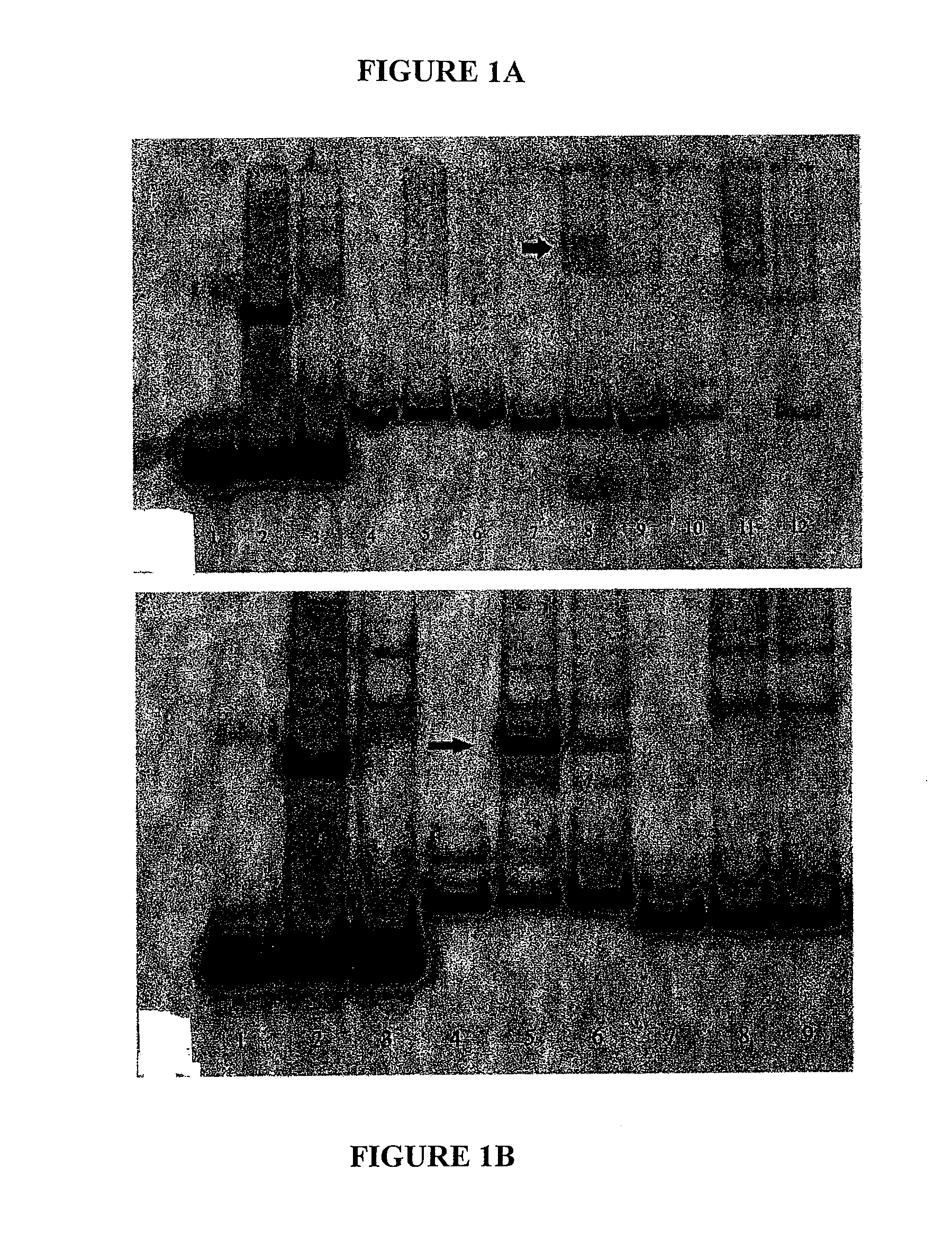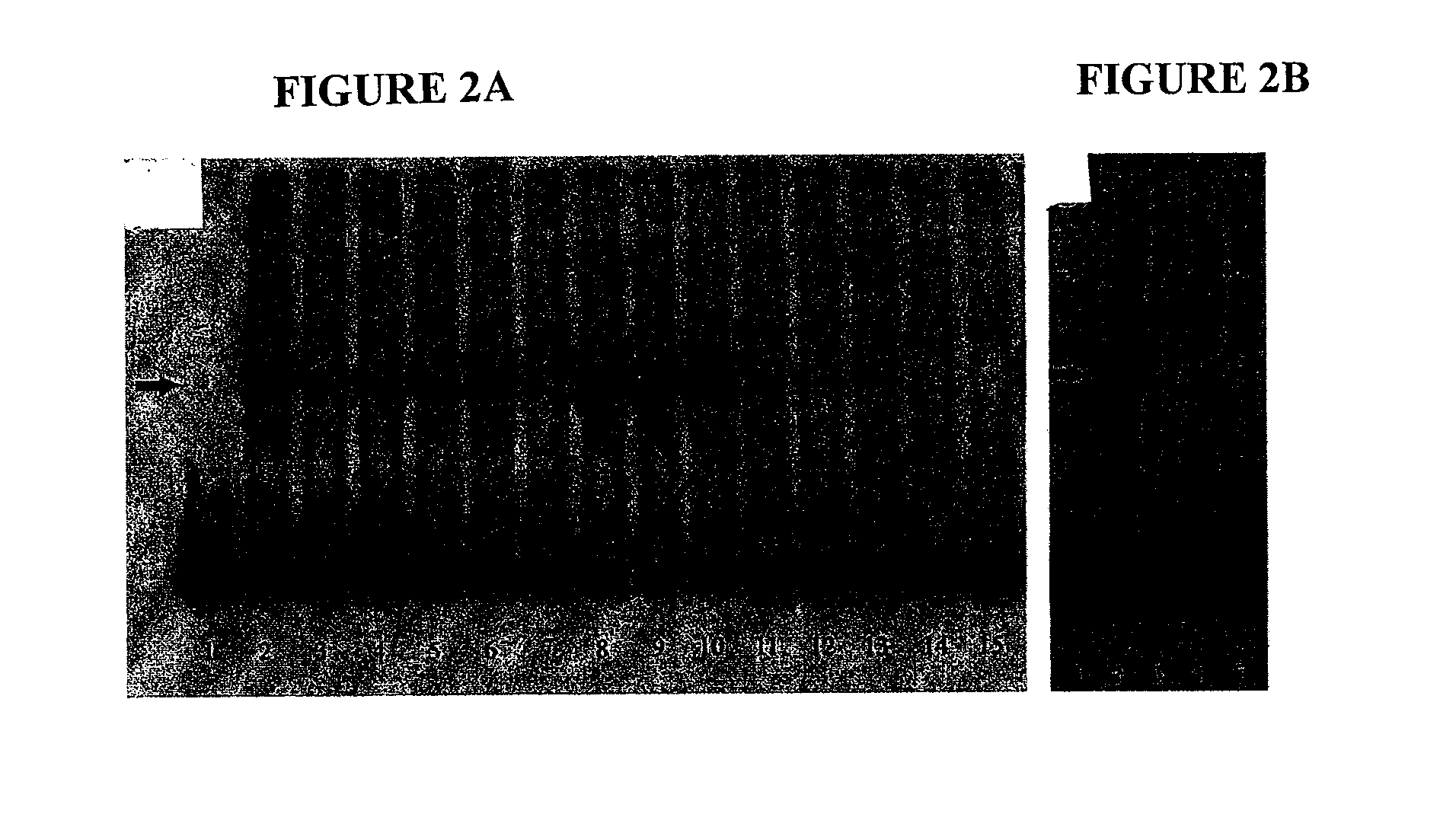Sodium-iodide symporter gene repressor binding site
a technology of symporter gene and binding site, which is applied in the field of nucleotide sequences, can solve the problems of no effective systemic cytotoxic agent, and achieve the effect of high stringency
- Summary
- Abstract
- Description
- Claims
- Application Information
AI Technical Summary
Benefits of technology
Problems solved by technology
Method used
Image
Examples
example 1
A Second NRBS (NRBS-D) in the hNIS Promoter
[0027]Five EMSA probes, SHIFT-1, -2, -3, -4, and -5, were prepared with PCR, radiolabeled, and used to probe KAK1 nuclear extract in EMSA. The EMSA results shown in FIG. 1 indicate that: 1) no specific signal for SHIFT-1 probe (FIG. 1A, lane 5), covering −1667 to −1468 bp; 2) multiple faint specific signals for SHIFT-2 probe (FIG. 1A, lane 8), covering −1467 to −1268 bp; 3) no specific signal for SHIFT-3 probe (FIG. 1A, lane 11), covering −1267 to −1068 bp; 4) one strong specific signal for SHIFT-4 probe (FIG. 1B, lane 5), covering −1067 to −868 bp; and 5) no specific signal for SHIFT-5 probe (FIG. 1B, lane 8), covering −873 to −708 bp. This shows that KAK1 nuclear extract contains one or more factors that can bind to the sequence from −1067 to −868 by in the hNIS promoter, further upstream from NRBS-P. We designate this region as a distal NRBS (NRBS-D).
example 2
The Core Sequence of NRBS-D is Homologous to NRBS-P and demonstrates Cross-Competition Between Both Sites
[0028]Seven PCR fragments and three annealed double-strand oligonucleotides were used as unlabeled competitors against the radiolabeled SHIFT-4 probe in EMSA to determine the core sequence for NRBS-D. The seven PCR fragments are: SHIFT-4.1 (150 bp; −1017 to −868), SHIFT-4.2 (100 bp; −967 to −868), SHIFT-4.3 (150 bp; −1067 to −918), SHIFT-4.4 (100 bp; −1017 to −918), SHIFT-4.5 (150 bp; −1017 to −868), SHIFT-4.6 (140 bp; −1007 to −868), and SHIFT-4.7 (130 bp; −997 to −868). The three annealed double-stranded oligonucleotides are: ds-411 (5′-tttattcctctgaggcagggtctattttat-3′, 30 bp; −1017 to −988) (SEQ ID NO.: 3), ds-412 (5′-tgaggcagggtctattttatccttgttaca-3′, 30 bp; −1007 to −978) (SEQ ID NO.: 4), and ds-413 (5′-tctattttatccttgttacagatggggaaa-3′, 30 bp; −997 to −968) (SEQ ID NO.: 5). Only the sequences of the sense strands are listed. Probe-A and annealed double-stranded Comp-1 were...
example 3
Association of TTF-2 with NRBS-P and NRBS-D
[0031]In supershift assays, antibodies against human Sp1 (E-3), c-Jun (H-79), c-Fos (H-125), AP-2a (C-18), TTF-1 (F-12), Pax8 (A-15), and PARP-1 failed to alter the EMSA signal mobilities, suggesting that their respective antigens are not associated with the NRBS-P site. This is consistent with other results showing that their respective consensus DNA target sequences are unable to compete against NRBS-P. The anti-TTF-2 antibody (S-18) shifted the EMSA signals, changing the mobility of one of the bands, showing faster migration, and simultaneously changing the single Comp-1 specific signal into multiple constituent bands with faster migration on the gel, as shown in FIG. 3A, lane 5. We attempted to further verify this phenomenon with two additional anti-TTF-2 commercial antibodies, recognizing different TTF-2 epitopes. Both of these antibodies (F-17, V-20) failed to alter the EMSA signals as achieved with the S-18 antibody. This indicates t...
PUM
| Property | Measurement | Unit |
|---|---|---|
| Electrical resistance | aaaaa | aaaaa |
| Transport properties | aaaaa | aaaaa |
Abstract
Description
Claims
Application Information
 Login to View More
Login to View More - R&D
- Intellectual Property
- Life Sciences
- Materials
- Tech Scout
- Unparalleled Data Quality
- Higher Quality Content
- 60% Fewer Hallucinations
Browse by: Latest US Patents, China's latest patents, Technical Efficacy Thesaurus, Application Domain, Technology Topic, Popular Technical Reports.
© 2025 PatSnap. All rights reserved.Legal|Privacy policy|Modern Slavery Act Transparency Statement|Sitemap|About US| Contact US: help@patsnap.com



